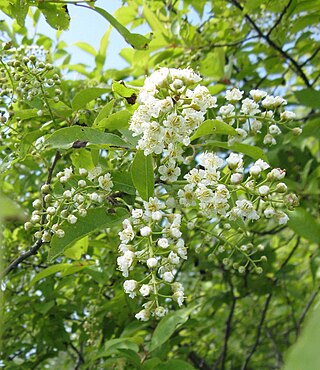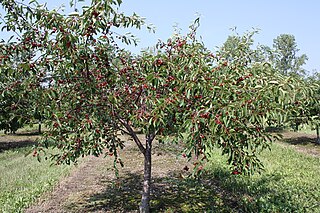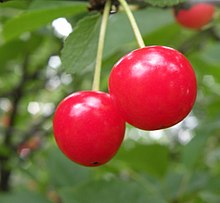
A cherry is the fruit of many plants of the genus Prunus, and is a fleshy drupe.

Prunus cerasus is a species of Prunus in the subgenus Cerasus (cherries), native to much of Europe, North Africa and West Asia. It is closely related to the sweet cherry, but has a fruit that is more acidic. Its sour pulp is edible.

A cherry blossom, also known as a Japanese cherry or sakura, is a flower of trees in the genus Prunus or the Prunus subgenus Cerasus. Wild species of the cherry tree are widely distributed, mainly in the Northern Hemisphere. They are common in East Asia, especially in Japan. They generally refer to ornamental cherry trees, not cherry trees grown for their fruit. The cherry blossom is considered the national flower of Japan.

Prunus virginiana, commonly called bitter-berry, chokecherry, Virginia bird cherry, and western chokecherry, is a species of bird cherry native to North America.

Prunus serrulata or Japanese cherry is a species of cherry tree that grows naturally in Japan, China, and Korea, and it also refers to a cultivar produced from Prunus speciosa, a cherry tree endemic in Japan. Historically, the Japanese have developed many cultivars by selective breeding of cherry trees, which are produced by the complicated crossing of several wild species, and they are used for ornamental purposes all over the world. Of these, the cultivars produced by complex interspecific hybrids based on the Oshima cherry are also known as the Cerasus Sato-zakura Group.

Prunus serotina, commonly called black cherry, wild black cherry, rum cherry, or mountain black cherry, is a deciduous tree or shrub of the genus Prunus. Despite being called black cherry, it is not very closely related to the commonly cultivated cherries such as sweet cherry, sour cherry and Japanese flowering cherries which belong to Prunus subg. Cerasus. Instead, P. serotina belongs to Prunus subg. Padus, a subgenus also including Eurasian bird cherry and chokecherry. The species is widespread and common in North America and South America.
Dwarf cherry as a name has been used for at least three species of small cherry trees:

The Evans Cherry also sold under the name 'Bali', is a sour cherry cultivar rediscovered in an old orchard near Edmonton, Alberta, Canada, and is significant because cherries were not considered viable in the harsh climate of the Canadian prairies, yet the specimen, discovered by Ieuan Evans, had been growing there since the 1920s. Grown on its own rootstock and self-pollinating, the Evans Cherry displays white blossoms in spring and bears abundant fruit.

Prunus cerasoides, commonly known as the wild Himalayan cherry or sour cherry, is a species of deciduous cherry tree in the family Rosaceae. It is found in southern and eastern Asia.

Griotte de Kleparow is a dark-red morello, or Griotte, type of cherry which originated from the outskirts of Lviv, modern Ukraine.

Prunus maackii, commonly called the Manchurian cherry or Amur chokecherry, is a species of cherry native to Korea and both banks of the Amur River, in Manchuria in northeastern China, and Amur Oblast and Primorye in southeastern Russia. It used to be considered a species of Prunus subg. Padus, but both morphological and molecular studies indicate it belongs to Prunus subg. Cerasus.

Prunus fruticosa, the European dwarf cherry, dwarf cherry, Mongolian cherry or steppe cherry is a deciduous, xerophytic, winter-hardy, cherry-bearing shrub. It is also called ground cherry and European ground cherry, but is not to be confused with plants in the distinct "Groundcherry" genus of Physalis.

Prunus tomentosa is a species of Prunus native to northern and western China, Korea, Mongolia, and possibly northern India. Common names for Prunus tomentosa include Nanjing cherry, Korean cherry, Manchu cherry, downy cherry, Shanghai cherry, Ando cherry, mountain cherry, Chinese bush cherry, and Chinese dwarf cherry.

The Ulster cherry is a sweet cherry cultivar that originated in the United States.

The Emperor Francis cherry is a sweet cherry cultivar (Prunus avium) that produces a bright red fruit which is resistant to cracking. In 1996, it was the source of the first cherry genetic map, which was created from a haploid-microspore derived population from the 'Emperor Francis' cultivar. It is also one of the sources of the 'Newfane' sweet cherry, which was created by crossing the 'Emperor Francis' with the 'Stella' cherry. It can be cross-pollinated with 'Montmorency' cherry.

Prunus avium, commonly called wild cherry, sweet cherry, gean, or bird cherry is a species of cherry, a flowering plant in the rose family, Rosaceae. It is native to Europe, Anatolia, Maghreb, and Western Asia, from the British Isles south to Morocco and Tunisia, north to the Trondheimsfjord region in Norway and east to the Caucasus and northern Iran, with a small isolated population in the western Himalaya. The species is widely cultivated in other regions and has become naturalized in North America and Australia.

Prunus pseudocerasus or Prunus pseudo-cerasus, the Chinese sour cherry or just Chinese cherry, is a species of cherry native to China and is used worldwide as an ornamental for its early spring cherry blossoms. The fruits of some cultivars are edible.
Van is a cultivar of cherry originating from Canada.

The Balaton cherry is a cultivar of sour cherry native to Hungary, where it was originally named Újfehértói Fürtös. It was introduced to the United States in the 1980s and is now grown there commercially.

Prunus × eminens or Prunus eminens is a species of small cherry tree native to central Europe. It is a naturally occurring hybrid of sour cherry, Prunus cerasus, and dwarf cherry, Prunus fruticosa, occasionally found where their ranges overlap. Like its parents, it is a tetraploid with 32 chromosomes. It is forming a hybrid swarm with, and threatening to extirpate, P. fruticosa in much of its western range through genetic pollution.



















